
|
2010 - Present |
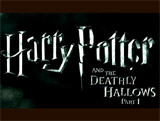
|
Harry Potter and the Deathly Hallows, Part 1 (2010) Although nominated for the Best Visual Effects Academy Awards Oscar, the film lost to Inception (2010). Many now common-place features of the Harry Potter films were actually special effects magic, often unnoticed or blending in seamlessly with the story, e.g.
In this particular film, notable action scenes were the flight to the Burrow on thestrals and brooms (and Hagrid's harrowing motorbike encounter with traffic, and tunnel, and Death-Eater attacks), and the two wand shoot-outs (in the coffee-house and in Malfoy Manor). Extremely advanced special effects techniques were used in the early scene in which 6 doppelganger Harry Potters were created, by having six of Harry's friends (George, Fred, Ron, Hermione, Fleur and Mundungus) drink Polyjuice Potion at Privet Drive. The multiple Harrys were designed to thwart the coming attack of Voldemort and his Death-Eaters.
The CGI characters of house-elves Kreacher (pictured) and Dobby were animated visual effects, as was python-like Nagini's early appearance, followed by its emergence from Bathilda Bagshot and subsequent attack against Harry. The illusionary vision Ron experienced while threatening to destroy the locket-horcrux with the Sword of Griffindor was a startling image of Harry and Hermione kissing topless, as well as a large dark monstrosity and spiders. Exceptional animation was evidenced in The Tale of the Three Brothers, homage to the hand-cut paper silhouettes in one of the earliest animations in cinematic history by Lotte Reiniger. |
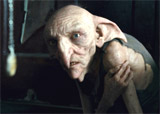 Kreacher 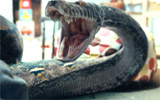 Nagini 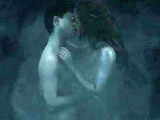 Vision
of Harry and Hermione Kissing Vision
of Harry and Hermione Kissing 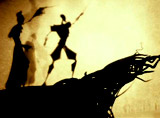
The Tale of the Three Brothers |
|||||||||

|
Inception (2010)
In the sci-fi heist thriller, Leonardo DiCaprio played the part of international fugitive Dominick "Dom" Cobb, a skilled espionage spy who performed thefts (or extractions) of corporate secrets by invading people's dreams. As a dream manipulator, he was tasked with one final, seemingly-impossible "inception" job - this time not to steal an idea ("an inception") but to plant one. "Dom" Cobb and his team entered the multi-leveled psyche of an energy tycoon (Cillian Murphy) to implant an idea about how he wouldn't follow in his father's footsteps. It told about a world where the subconscious could be infiltrated through dreams, and entire worlds could be created and altered with the mind. Director Nolan consciously limited the use of CGI to avoid a fake, digital look to the visuals, instead relying more on practical effects. Some of the most astonishing, surreal and ground-breaking special effects were seen in the various dreamscapes where the laws of logic and gravity didn't hold.
|
 Parisian Bistro Scene 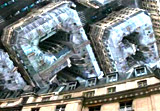 Folding City Block 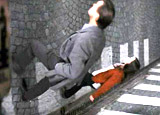 Walking Up a Wall 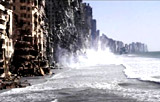 Crumbling Into Sea 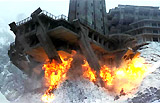 Exploding Concrete Fortress |
|||||||||
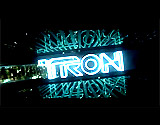
|
Tron: Legacy (2010) Director Joseph Kosinski's action-adventure sci-fi sequel built upon the success and visuals of its ground-breaking predecessor, TRON (1982), although it was not nominated in the category of Best Visual Effects. Principal shooting took only a few months, but there were two years of post-production work involving 1,565 visual effects shots. Most sequences were shot in 3D and ten companies were involved with the extensive visual effects work, including chroma keying. Settings included physically-constructed sets (using real materials such as glass, concrete, and steel), on-location sites, and also completely computer-generated landscapes. There were new, more stylish and updated designs for the light-cycles.
Star Jeff Bridges took two roles - one digitally-enhanced:
Bridges' younger-looking face (taken from Against All Odds (1984)) was digitally-substituted or masked, in post-production, onto the face of villainous, digital doppelganger Clu (Codified Likeness Utility), with Flynn's likeness. Four microcameras with infrared sensors captured all 134 dots on Bridges' face to record his facial movements. Actor Fred Tatasciore's voice was recorded for the voice-over, while the character's physical body was physically portrayed by performance double John Reardon. |
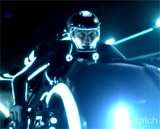 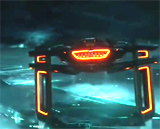 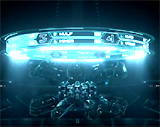 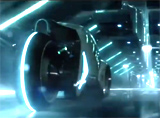 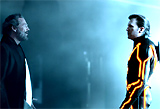 Flynn vs. Clu Confrontation |
|||||||||

|
Hugo (2011)
It had 11 Oscar nominations, and won five awards (Cinematography, Art Direction, Sound Mixing, and Sound Editing), including Best Visual Effects. The four other nominees in the category were: The Girl With the Dragon Tattoo (2011), Transformers: Dark of the Moon (2011), War Horse (2011), and Drive (2001). The overall look and color of the film was to imitate an early color process in cinematic history (pioneered by the Lumiere Brothers in France), known as Autochrome. The source novel of the fully digital film was Brian Selznick's 'The Invention of Hugo Cabret' - first published in 2007. The tale was basically a quest to solve the mystery of George Méliès (1861-1938), the innovative and pioneering filmmaker (known for trick stop-motion shots, multiple exposures and time-lapse photography) who became forlorn and discouraged in his later years. When his film ventures failed, he had to resort to selling candy and toys (a role played by Ben Kingsley in the film) at the Montparnasse train station in Paris. The story was about a 12 year-old orphaned, mechanically-inclined boy named Hugo Cabret (Asa Butterfield), who lived in 1930s Paris inside the Gare Montparnasse train station. The opening scene (created by ILM) was a tracking shot (resembling streak photography) of the city of Paris, ending at the train station. It took one year to film, and required 1000 computers to render each frame required for the shot. One of the most amazing dream sequences (using detailed miniature models and green-screen F/X technology) was the derailment and crash of a train. It was a recreation of the famous derailment of the Granville-Paris Express at Gare Montparnasse in 1895. Hugo jumped down into the tracks, to retrieve a heart-shaped key (that operated an automaton or mechanical man, an F/X model), with words inscribed on it: "CABRET ET FILS HORLOGERS."
Suddenly, the track began to vibrate, signaling the approach of a large steam locomotive into the station. The engineer spotted the individual ("Boy on the tracks!") and attempted to break the fast-moving train. Sparks flew as the train tried to screech to a halt. The boy put up his hand and diverted the train onto the platform, where it rammed into various vendors and a cafe, and ended up crashing through the outside wall. Another remarkable scene, another dream sequence, was the one in which Hugo imagined himself turning into a mechanical machine or automaton.
|
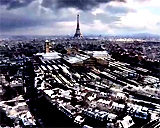 The Opening Tracking Shot 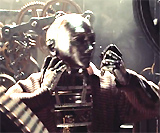 Hugo's Dream of Turning into an Automaton 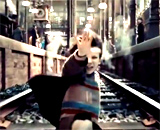 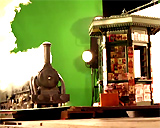 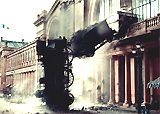 The Train Derailment and Crash 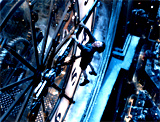 Hugo Hanging From Clock - Homage to Safety Last! (1923) 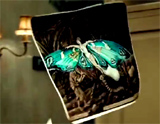 The "Flip-Chart" Effect |
|||||||||
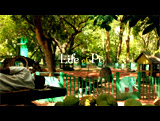
|
Life of Pi (2012)
It told about survival re-created the 2001 novel by Yann Martel about an Indian boy named Pi (Suraj Sharma), aka Piscine Molitor "Pi" Patel. After the tragic sinking of a Japanese freighter in the middle of the Pacific Ocean, Pi became trapped on a life raft with a Bengal tiger, a spotted hyena, a zebra and an orangutan. The live-action computer-animated film relied heavily on 3D and CGI to represent the various animals on the boat adrift at sea. Elaborate digital wire-frames were drawn to reproduce the zoo animals.
A number of visual effects companies were commissioned to create the digital ocean and storm, other environments (the flying fish sequence), the exotic animals, including a Bengal tiger named Richard Parker with realistic-looking fur, a breeching humpback whale, and meerkats on an island. It seamlessly balanced technology and the beauty of natural wonders. A huge blue-screen surrounded wave tank (75 by 30 meters and three meters deep) was employed to create the storm sequence. |
 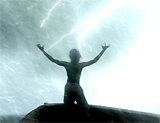 A Tank And Blue-Screen 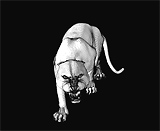 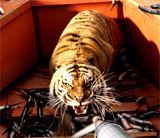 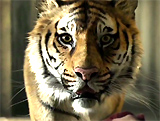 Wire-Frame Tiger Model |
|||||||||

|
Gravity (2013)
It told about two surviving astronauts stranded in the vastness and beauty of space after the destruction of their NASA space shuttle Explorer by stray space debris:
To create or simulate the illusion of weightlessness in space's zero-g environment, actress Sandra Bullock was required to be hooked up in a giant mechanical rig inside a cube of light. The effect was created using a combination of motion controlled cameras. Cameras were strapped to huge robotic arms and the actor was put in a variety of different rigs within the 3-D light box.
It was incredible to realize that most of the film was digitally created by visual effects artists -- including all the shots of the vastness of space, the Earth, the stars, the space shuttles, the Hubble Telescope, the International Space Station (ISS), the debris fragments, and the spacesuits. |
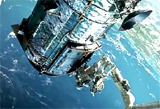 Outer Space 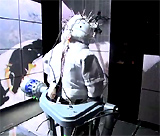 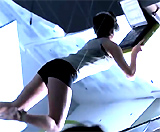 The Light Box and Rig Set-Up |
|||||||||
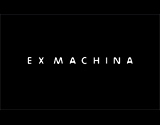
|
Ex Machina (2014, UK)
Writer/director Alex Garland's directorial debut film was a sci-fi thriller that asked: "What constitutes true artificial intelligence?" In the story, mid-20s coder-programmer Caleb Smith (Domhnall Gleeson) was invited by Nathan Bateman (Oscar Isaac), the eccentric CEO of search engine computer company BlueBook (a hybrid of Google and Facebook), to visit his isolated and reclusive mountain "research facility" (with walls of glass) in Alaska for a week, where he was studying artificial intelligence. During Caleb's work, he was tasked by Nathan to administer the Turing test to a newly-developed android - a walking, talking, expressive humanoid robot named Ava (Oscar-winning Alicia Vikander for The Danish Girl (2015) in the same year), to evaluate her emotions and reactions. Ava was a marvelous, realistic F/X creation, composed of encased circuitry within a metal skeleton and human face/hands/feet. She had see-through limbs, a chrome-domed cranium, and a glowing, see-through midriff power-core. |
   Ava (Alicia Vikander) |
|||||||||

|
Interstellar (2014)
The film was authentically-researched to bring together art and science, using the advice of CalTech astrophysicists, among others. The VFX team was also inspired by images taken of the Apollo Lunar missions of the 1960s and 1970s, and of the astronauts on the International Space Station. It told about a time when Earth was becoming uninhabitable, a team of research scientists and widowed former NASA pilot Cooper (Matthew McConaughey) searched in space for a suitable Earth-like planet. Their plan was to enter a wormhole as a pathway to a distant galaxy where there might be habitable planets. While the Saturn V launch in the film was digitally created, most of the major effects, including shots of the Ranger shuttles and Endurance, were not digital. Miniatures (or models) hadn't been used to this scale in a film for awhile (i.e. the Endurance model was about 25 feet in length). The objective was to be more realistic by using the models, rather than having less real digitally-created spaceships. It also boasted the first scientifically-accurate display of a super-massive black hole (known as Gargantua) on the big screen, and of other phenomena in space. [Note: Black holes were historically represented as large drain holes with swirling currents, but in fact, black holes were more accurately depicted as three-dimensional spheres.] Also, new software was used to render gigantic tidal waves that towered more than 4,000 feet high in an alien world. And in the scene involving a Tesseract (a four dimensional space allowing time to be seen as a physical dimension), the visual effects team scanned (in high resolution) the entire farmhouse bedroom set, without using any shortcut green-screen effects. In the scene, Cooper entered the 5th-dimensional version of his daughter "Murph" Cooper's (Jessica Chastain) bedroom, to make contact with her. He sent messages to Murph via books falling off the shelf, and then sent complicated quantum data (regarding gravity) to her by moving the second hands on her wrist-watch. Dust storms in the film were a mixture between digitally-fabricated computer graphics and practical effects. The film's two robots (TARS and CASE) were presented without recognizable human features. TARS was a talkative, witty, boxy, monolithic-shaped robot with a voice like HAL (with nods to Kubrick's 2001: A Space Odyssey (1968)) and a computer screen. CASE was TARS' twin, although more quiet and reserved. Two versions of TARS were filmed - live-action, and digitally-created. |
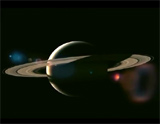 Orbiting Saturn  Cooper and Dr. Amelia Brand Sucked Into Gargantua - Black Hole  Shuttle Atop Massive Tidal Wave on Miller's Planet  TARS  CASE |
|||||||||